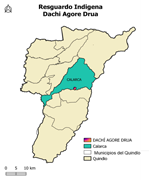Conflict management around territory: experiences of the Embera Chamí people in Quindío
DOI:
https://doi.org/10.15381/espiral.v6i12.28030Keywords:
Intercultural conflict management from within or from below, interculturality, territory, indigenous people, peasantsAbstract
Ethnic and peasant communities, due to their realities, histories, and contexts, have managed their conflicts by resorting to their own experiences framed by cultural and identity matrices. This may be since conventional or State-driven conflict resolution and management mechanisms have often been proposed and imposed with a lack of knowledge of the realities of these communities. Particularly, this type of conflict management has had a place in the management of conflicts involving culturally different communities. In this type of conflicts, territory is almost always the trigger, due to the way each culture has an interpretation or connection with it. This is precisely where the case study between the Emberas Chamí of the Dachi Agoré Drua Resguardo and the surrounding peasant communities comes in. These two populations have given a different connotation to the territory, which has allowed this, being linked to the identity and culture of indigenous people and peasants, to become an additional element that allows the management of conflicts between them.
For this reason, the present research is carried out within the parameters of intercultural dialogue, generating a dynamic of equal peers between the Embera Chami community and myself, in my role as researcher. In order not to enter into an extractivism of concomitance and, on the contrary, to generate an exchange of knowledge, from participatory action-research and methodologies that position the community’s own knowledge as equally valid as the western one.

Downloads
Published
Issue
Section
License
Copyright (c) 2024 Fabián Mauricio Rosas Rosas

This work is licensed under a Creative Commons Attribution 4.0 International License.
LOS AUTORES RETIENEN SUS DERECHOS:
a. Los autores retienen sus derechos de marca y patente, y también sobre cualquier proceso o procedimiento descrito en el artículo.
b. Los autores retienen el derecho de compartir, copiar, distribuir, ejecutar y comunicar públicamente el artículo publicado en la revista Espiral (por ejemplo, colocarlo en un repositorio institucional o publicarlo en un libro), con un reconocimiento de su publicación inicial en la revista Espiral.
c. Los autores retienen el derecho a hacer una posterior publicación de su trabajo, de utilizar el artículo o cualquier parte de aquel (por ejemplo: una compilación de sus trabajos, notas para conferencias, tesis, o para un libro), siempre que indiquen la fuente de publicación (autores del trabajo, revista, volumen, número y fecha).





